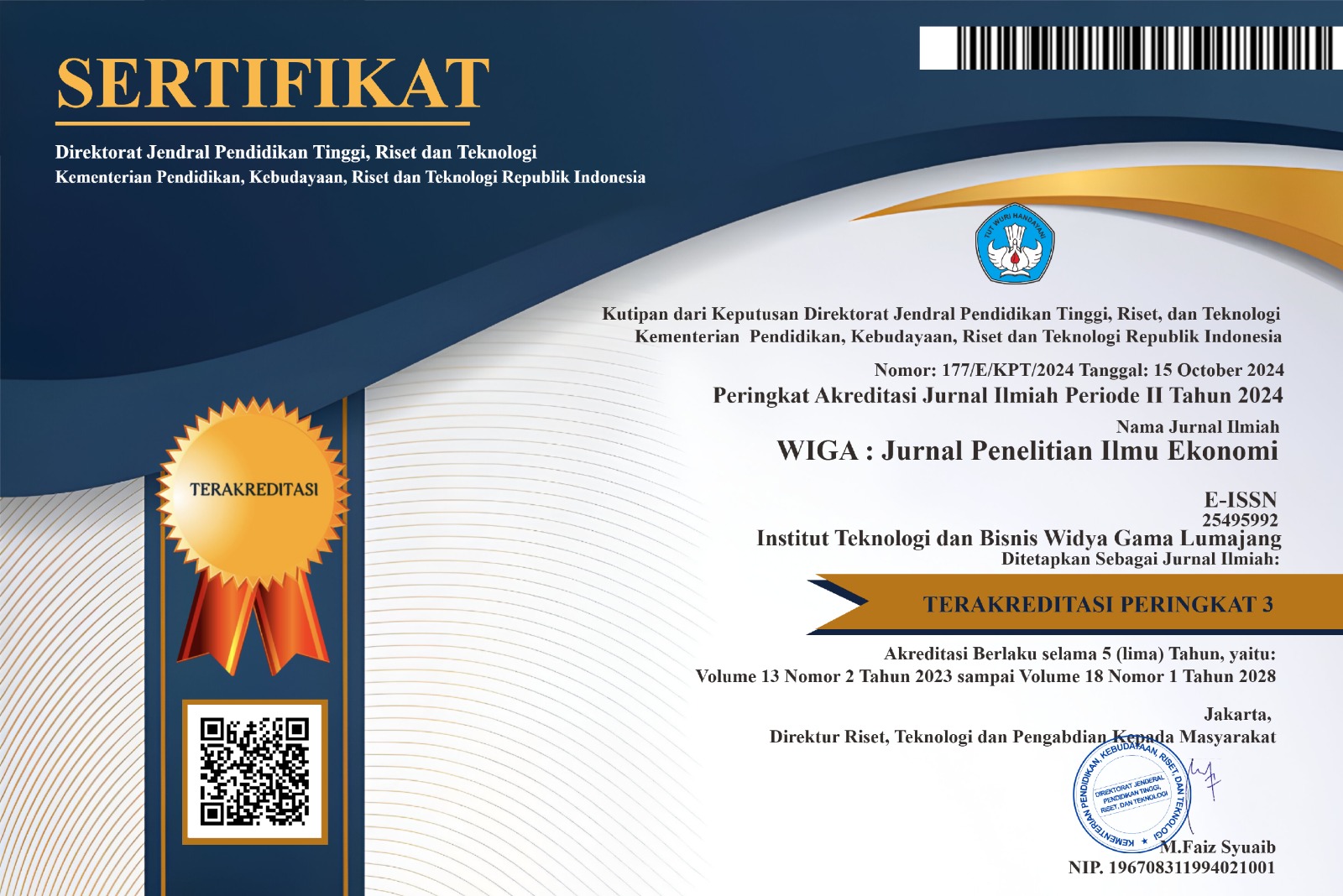Digital Economy: Technology Acceptance Model Supports Indonesia's Sustainable Economy (Continuance Intention in Generation Z based on Customer Experience using Shopee)
DOI:
https://doi.org/10.30741/wiga.v15i1.1439Keywords:
Continuance Intention, Customer Experience, Perceived Ease of Use, Perceived Risk, perceived usefulnessAbstract
Data security and privacy are crucial points that must always be reviewed to ensure better data protection in the era of digitalization. How Generation Z can measure readiness and risks is a way to prepare individuals for engaging in online shopping/e-commerce activities. A marketing strategy called postmodern marketing is one of the company's efforts to gauge how Generation Z perceives their experience from using an e-commerce application. The objective of this study is to examine Generation Z's interaction with e-commerce applications in their everyday routines, emphasizing their perceived usefulness, ease of use, and risk. The research employs SEM-PLS to analyze data from questionnaires. The study collected responses from 346 respondents using purposive sampling technique. The results show that the perceived risk can be overlooked when customers feel that the perceived benefits are greater than the anticipated risks. TAM also has a stronger in-fluence when mediated by customer experience.
Downloads
References
Agrebi, S., & Jallais, J. (2015). Explain the intention to use smartphones for mobile shopping. Journal of Retailing and Consumer Services, 22, 16–23. https://doi.org/10.1016/j.jretconser.2014.09.003
Ahdiat, A. (2024). 5 E-Commerce dengan Pengunjung Terbanyak di Indonesia (Januari-Desember 2023)*. databoks.katadata.co.id. https://www.similarweb.com/website/shopee.co.id/#traffic
AJZEN, I. (1991). The Theory of Planned Behavior. ORGANIZATIONAL BEHAVIOR AND HUMAN DECISION PROCESSES, 50(2), 179–211. https://doi.org/https://doi.org/10.1016/0749-5978(91)90020-T
Ajzen, I., & Fishbein, M. (1977). Attitude-behavior relations: A theoretical analysis and review of empirical research. Psychological Bulletin, 84(5), 888–918. https://doi.org/10.1037/0033-2909.84.5.888
Annur, C. M. (2023). E-commerce, Sektor Penyumbang Ekonomi Digital Terbesar Indonesia pada 2023. In databoks.katadata.co.id. https://services.google.com/fh/files/mis
Asia, S., & Zs, G. (2024). Shopee ’ s ‘ The Future of Shopping ’ study reveals 7 in 10 Gen Z shoppers choose e-commerce as research source for informed spending. 1–6.
Bhattacherjee, A. (2001). Bhattacherjee/lnformation Systems Continuance MIS Qarterjy UNDERSTANDING INFORMATION SYSTEMS CONTINUANCE: AN EXPECTATION-CONFIRMATION MODEL1 Motivation for the Study. MIS Quarterly, 25(3), 351–370.
Budiman, C., Tanjaya, K., Zulkarnain, A., & Rosman, D. (2023). The effect of paylater on purchase decision and continuance intention in generation Z at GoFood application. E3S Web of Conferences, 426. https://doi.org/10.1051/e3sconf/202342601084
Caffaro, F., Micheletti Cremasco, M., Roccato, M., & Cavallo, E. (2020). Drivers of farmers’ intention to adopt technological innovations in Italy: The role of information sources, perceived usefulness, and perceived ease of use. Journal of Rural Studies, 76(April), 264–271. https://doi.org/10.1016/j.jrurstud.2020.04.028
Dabbous, A., & Barakat, K. A. (2020). Bridging the online offline gap: Assessing the impact of brands’ social network content quality on brand awareness and purchase intention. Journal of Retailing and Consumer Services, 53(March 2019), 101966. https://doi.org/10.1016/j.jretconser.2019.101966
Davis, F. D. (1985). A technology acceptance model for empirically testing new end-user information systems: Theory and results. Management, Ph.D.(January 1985), 291. https://doi.org/oclc/56932490
Esmaeili, A., Haghgoo, I., Davidaviciene, V., & Meidute-Kavaliauskiene, I. (2021). Customer loyalty in mobile banking: Evaluation of perceived risk, relative advantages, and usability factors. Engineering Economics, 32(1), 70–81. https://doi.org/10.5755/j01.ee.32.1.25286
Fauzi, A. A., & Sheng, M. L. (2020). Ride-hailing apps’ continuance intention among different consumer groups in Indonesia: the role of personal innovativeness and perceived utilitarian and hedonic value. Asia Pacific Journal of Marketing and Logistics, 33(5), 1195–1219. https://doi.org/10.1108/APJML-05-2019-0332
Gefen, D. (2002). Customer Loyalty in E-Commerce. Journal of the Association for Information Systems, 3(1), 27–53. https://doi.org/10.17705/1jais.00022
Grewal, D., Noble, S. M., Roggeveen, A. L., & Nordfalt, J. (2020). The future of in-store technology. Journal of the Academy of Marketing Science, 48(1), 96–113. https://doi.org/10.1007/s11747-019-00697-z
Hajli, N., Lin, X., Featherman, M., & Wang, Y. (2014). Social word of mouth: How trust develops in the market. International Journal of Market Research, 56(5), 673–689. https://doi.org/10.2501/ijmr-2014-045
Homburg, C., Jozić, D., & Kuehnl, C. (2017). Customer experience management: toward implementing an evolving marketing concept. Journal of the Academy of Marketing Science, 45(3), 377–401. https://doi.org/10.1007/s11747-015-0460-7
Kim, B., & Kang, M. (2016). How user loyalty and nonconscious inertia influence the continued use of mobile communications platforms. International Journal of Mobile Communications, 14(4), 387–410. https://doi.org/10.1504/IJMC.2016.077337
Kim, D. J., Ferrin, D. L., & Rao, H. R. (2008). A trust-based consumer decision-making model in electronic commerce: The role of trust, perceived risk, and their antecedents. Decision Support Systems, 44(2), 544–564. https://doi.org/10.1016/j.dss.2007.07.001
Kim, J., Li, Y., & Choi, J. (2023). Understanding the Continuance Intention to Use Chatbot Services. Asia Marketing Journal, 25(3), 99–110. https://doi.org/10.53728/2765-6500.1613
Kim, T., & Chiu, W. (2019). Consumer acceptance of sports wearable technology: the role of technology readiness. International Journal of Sports Marketing and Sponsorship, 20(1), 109–126. https://doi.org/10.1108/IJSMS-06-2017-0050
Kotler, P., Kartajaya, H., & Setiawan, I. (2024). Marketing 5.0: Teknologi untuk Kemanusiaan. Gramedia Pustaka Utama.
Kusumawati, A., & Rahayu, K. S. (2020). The effect of experience quality on customer perceived value and customer satisfaction and its impact on customer loyalty. TQM Journal, 32(6), 1525–1540. https://doi.org/10.1108/TQM-05-2019-0150
Latifa, N., Putri, I., & Hakim, I. (2023). New Consumer Landscape: Sebuah Riset Perilaku Konsumen menuju Society 5.0. Jurnal Mirai Management, 8(2), 347–355.
Leon, S. (2018). Service mobile apps: a millennial generation perspective. Industrial Management and Data Systems, 118(9), 1837–1860. https://doi.org/10.1108/IMDS-10-2017-0479
Liu-Thompkins, Y., Okazaki, S., & Li, H. (2022). Artificial empathy in marketing interactions: Bridging the human-AI gap in affective and social customer experience. Journal of the Academy of Marketing Science, 50(6), 1198–1218. https://doi.org/10.1007/s11747-022-00892-5
Ma, Y., Ruangkanjanases, A., & Chen, S. C. (2019). Investigating the impact of critical factors on continuance intention towards cross-border shopping websites. Sustainability (Switzerland), 11(21). https://doi.org/10.3390/su11215914
Malik, A. N. A., & Annuar, S. N. S. (2021). The Effect of Perceived Usefulness, Perceived Ease of Use, Reward, and Perceived Risk toward E-Wallet Usage Intention. Eurasian Studies in Business and Economics, 17, 115–130. https://doi.org/10.1007/978-3-030-65147-3_8
Mascarenhas, A. B., Perpétuo, C. K., Barrote, E. B., & Perides, M. P. (2021). The influence of perceptions of risks and benefits on the continuity of use of fintech services. Brazilian Business Review, 18(1), 1–21. https://doi.org/10.15728/BBR.2021.18.1.1
McCole, P., Ramsey, E., & Williams, J. (2010). Trust considerations on attitudes towards online purchasing: The moderating effect of privacy and security concerns. Journal of Business Research, 63(9–10), 1018–1024. https://doi.org/10.1016/j.jbusres.2009.02.025
Nico, A., Hari, Y., & Darmanto. (2018). Kajian Technology Acceptance Model Untuk Pengembangan Model E-Learning. Prosiding Seminar Nasional Ilmu Terapan, 1(1), 1–6. https://ojs.widyakartika.ac.id/index.php/sniter/article/view/86%0Ahttps://ojs.widyakartika.ac.id/index.php/sniter/article/download/86/83
Park, S., & Tussyadiah, I. P. (2017). Multidimensional Facets of Perceived Risk in Mobile Travel Booking. Journal of Travel Research, 56(7), 854–867. https://doi.org/10.1177/0047287516675062
Pei, X. L., Guo, J. N., Wu, T. J., Zhou, W. X., & Yeh, S. P. (2020). Does the effect of customer experience on customer satisfaction create a sustainable competitive advantage? A comparative study of different shopping situations. Sustainability (Switzerland), 12(18), 1–19. https://doi.org/10.3390/SU12187436
Putri, N. L. I. (2023). Analisis Studi Perilaku Konsumen Keputusan Pembelian Skincare dalam Menentukan. YUME : Journal of Management, 6(3), 145–151.
Rachmawati, D. (2024). YLKI Ungkap Pengaduan Konsumen Terbanyak di Sektor E-commerce. Bisnis.com, 1. https://ekonomi.bisnis.com/read/20240123/12/1734816/ylki-ungkap-pengaduan-konsumen-terbanyak-di-sektor-e-commerce
Rosariana, B., & Rahmad, B. (2021). Generasi “Milenial” Dan Generasi “Kolonial.” KPKNL Pontianak. https://www.djkn.kemenkeu.go.id/kpknl-pontianak/baca-artikel/14262/Generasi-Milenial-Dan-Generasi-Kolonial.html#:~:text=Adapun Gen Z%2C merupakan generasi,berusia 40-55 tahun).
Ryu, H. (2018). Industrial Management & Data Systems Article information : What makes users willing or hesitant to use Fintech ?: The moderating effect of user type. Industrial Management & Data Systems, 118(3), 541–569.
Said, L. R., Anggela, M., & Fariany, G. R. (2023). Online Purchase Decision of Gen Z Students at Shopee Marketplace. International Journal of Professional Business Review, 8(5), e01187. https://doi.org/10.26668/businessreview/2023.v8i5.1187
Saripah, saripah, Putri, A. A., & Darwin, R. (2016). Pengaruh Kepercayaan, Persepsi Kebermanfaatan, Persepsi Risiko dan Kepuasan Wajib Pajak Terhadap Penggunaan e-filling bagi Wajib Pajak Orang Pribadi di KPP Pratama Pekanbaru Tampan Tahun 2015 Effect of trust, perception of usefulness, perception of risk, . Jurnal Akuntansi & Ekonomika, 6(2), 134–149. https://ejurnal.umri.ac.id/index.php/jae/article/view/758
Siagian, H., Tarigan, Z. J. H., & Ubud, S. (2022). The effect of electronic word of mouth on online customer loyalty through perceived ease of use and information sharing. International Journal of Data and Network Science, 6(4), 1155–1168. https://doi.org/10.5267/j.ijdns.2022.7.004
Skandalis, A., Byrom, J., & Banister, E. (2019). Experiential marketing and the changing nature of extraordinary experiences in post-postmodern consumer culture. Journal of Business Research, 97(January 2017), 43–50. https://doi.org/10.1016/j.jbusres.2018.12.056
Tjiptono, F., & Chandra, G. (2017). Pemasaran Strategik Edisi 3 (3 ed.). Andi Ofset.
Tjiptono, F., & Chandra, G. (2020). Pemasaran Strategik: Domain, Determinan, Dinamika (F. Tjiptono (ed.)). Penerbit ANDI.
Venkatesh, V., & Davis, F. D. (2000). Theoretical extension of the Technology Acceptance Model: Four longitudinal field studies. Management Science, 46(2), 186–204. https://doi.org/10.1287/mnsc.46.2.186.11926
Venny Setyadi, E., Suarly, R., Handoko, R., & Ali, A. (2020). Faktor-Faktor yang Mempengaruhi Continuance Intention dari Pengguna Pada Layanan M-Payment (Studi Kasus Go-Pay). Kajian Branding Indonesia, 2(2), 162–200. https://doi.org/10.21632/kbi.2.2.162-200
Wang, X., Lu, A., Lin, T., Liu, S., Song, T., Huang, X., & Jiang, L. (2022). Perceived usefulness predicts second language learners’ continuance intention toward language learning applications: a serial multiple mediation model of integrative motivation and flow. Education and Information Technologies, 27(4), 5033–5049. https://doi.org/10.1007/s10639-021-10822-7
Yan, M., Filieri, R., & Gorton, M. (2021). Continuance intention of online technologies: A systematic literature review. International Journal of Information Management, 58(July 2020), 102315. https://doi.org/10.1016/j.ijinfomgt.2021.102315
Downloads
Published
How to Cite
Issue
Section
License
Copyright (c) 2025 Nur Latifa Isnaini Putri, Novy Fitria, Istichomah

This work is licensed under a Creative Commons Attribution-NonCommercial 4.0 International License.










